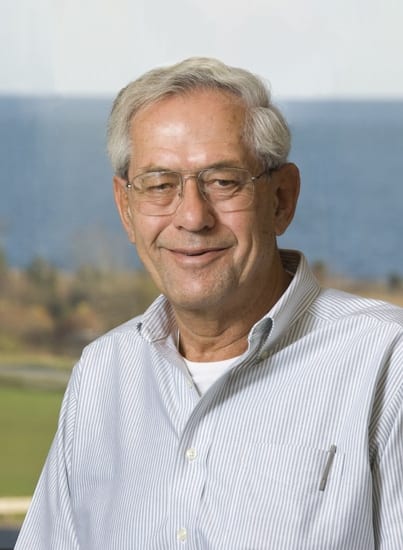News Releases
WHOI Study Calculates Volume and Depth of the World?s Oceans
How high is the sky? Scientists have a pretty good handle on that one, what with their knowledge of the troposphere, stratosphere an the other ?o-spheres.? Now, thanks to new work headed by the Woods Hole Oceanographic Institution (WHOI), they are closing in on the other half of that age-old query: How deep is the ocean?
Read MoreWHOI scientists find ancient asphalt domes off California coast
They paved paradise and, it turns out, actually did put up a parking lot. A big one. Some 700 feet deep in the waters off California?s jewel of a coastal resort, Santa Barbara, sits a group of football-field-sized asphalt domes unlike any other underwater features known to exist. About 35,000 years ago, a series of apparent undersea volcanoes deposited massive flows of petroleum 10 miles offshore. The deposits hardened into domes that were discovered recently by scientists from the Woods Hole Oceanographic Institution (WHOI) and UC Santa Barbara (UCSB).
James E. Cloern Wins Ketchum Award
The Woods Hole Oceanographic Institution (WHOI) has chosen James E. Cloern, a senior research scientist at the U.S. Geological Survey for the last 34 years, as the recipient of the 2010 Bostwick H. Ketchum Award.
Read MoreLong-Distance Larvae Speed to New Undersea Vent Homes
Working in a rare, ?natural seafloor laboratory? of hydrothermal vents that had just been rocked by a volcanic eruption, scientists from the Woods Hole Oceanographic Institution (WHOI) and other institutions have discovered what they believe is an undersea superhighway carrying tiny life forms unprecedented distances to inhabit the post-eruption site.
Read MoreNow in Broadband: Acoustic Imaging of the Ocean
Researchers at Woods Hole Oceanographic Institution (WHOI) have developed two advanced broadband acoustic systems that they believe could represent the acoustic equivalent of the leap from black-and-white television to high-definition […]
Read MoreWHOI Expertise, Technology, Tapped for Search for Air France Flight 447
The Woods Hole Oceanographic Institution (WHOI) is part of an international sea search operation formed to locate the deep-sea wreck site of Air France Flight 447 and to retrieve the flight recorders from the Airbus A 330.
Read MoreCape Broadband Network to Benefit Woods Hole Institutions
WOODS HOLE, MA—Woods Hole scientists are hailing last week’s announcement of $32 million in federal stimulus funds awarded to the OpenCape Corporation to construct a new broadband network across southeastern […]
Read MorePioneering Deep-Sea Robot Lost at Sea
A pioneering deep-sea exploration robot—one of the first successful submersible vehicles that was both unmanned and untethered to surface ships—was lost at sea Friday, March 5, on a research expedition […]
Read MoreChile Quake Occurred in Zone of “Increased Stress”
The massive, 8.8-magnitude earthquake that struck Chile Feb. 27 occurred in an offshore zone that was under increased stress caused by a 1960 quake of magnitude 9.5, according to geologist Jian Lin of the Woods Hole Oceanographic Institution (WHOI).
Read MoreResearchers Issue Outlook for a Significant New England ‘Red Tide’ in 2010
Today, scientists from the NOAA-funded Gulf of Maine Toxicity (GOMTOX) project issued an outlook for a significant regional bloom of a toxic alga that can cause ‘red tides’ in the […]
Read MoreOptical system promises to revolutionize undersea communications
In a technological advance that its developers are likening to the cell phone and wireless Internet access, Woods Hole Oceanographic Institution (WHOI) scientists and engineers have devised an undersea optical communications system that?complemented by acoustics?enables a virtual revolution in high-speed undersea data collection and transmission.
Read MoreWHOI contributes to special seamount issue of Oceanography magazine
Woods Hole Oceanographic Institution (WHOI) biologist Timothy M. Shank is among five guest editors of a newly published special edition of the research journal Oceanography on the oceans? seamounts, submerged isolated mountains in the sea. Shank is also a contributor to the special Oceanography edition.
Read MoreInternational Group of Scientists Collaborate to Communicate about Ocean Acidification
Climate change is a well-known problem resulting from the burning of fossil fuels and the subsequent release of carbon dioxide (CO2) into the atmosphere. But a separate, lesser-known problem resulting […]
Read MoreTeam finds subtropical waters flushing through Greenland fjord
Waters from warmer latitudes — or subtropical waters — are reaching Greenland’s glaciers, driving melting and likely triggering an acceleration of ice loss, reports a team of researchers led by […]
Read MoreWHOI Expert: Haiti quake occurred in complex, active seismic region
The magnitude 7.0 earthquake that triggered disastrous destruction and mounting death tolls in Haiti this week occurred in a highly complex tangle of tectonic faults near the intersection of the Caribbean and North American crustal plates, according to a quake expert at the Woods Hole Oceanographic Institution (WHOI) who has studied faults in the region and throughout the world.
Read MoreWHOI Receives $8.1 Million Grant to Construct New Laboratory
The Woods Hole Oceanographic Institution (WHOI) will receive $8.1 million from the U.S. Commerce Department’s National Institute of Standards and Technology (NIST) to construct the Laboratory for Ocean Sensors and […]
Read MoreWHOI-Operated ROV Jason Images the Discovery of the Deepest Explosive Eruption on the Sea Floor
Oceanographers using the remotely operated vehicle (ROV) Jason discovered and recorded the first video and still images of a deep-sea volcano actively erupting molten lava on the seafloor.
Jason, designed and […]
Read MoreTwo WHOI Scientists Named Fellows of the American Association for the Advancement of Science
John Farrington and David Gallo of the Woods Hole Oceanographic Institution (WHOI) have been named fellows of the American Association for the Advancement of Science (AAAS). Election as a fellow is an honor bestowed upon AAAS members by their peers.
Read MoreWoods Hole Consortium Delegates Participating in U.N. Climate Change Conference in Copenhagen this Week
CONTACTS:
Andrea Early, Marine Biological Laboratory
508-289-7652; aearly@mbl.edu
Media Relations Office, Woods Hole Oceanographic Institution
508-289-3340; media@whoi.edu
Elizabeth Braun, Woods Hole Research Center
508-540-9900, x109; ebraun@whrc.org
WOODS HOLE, MA—Directors and scientists […]
Read MoreIn CO2-rich Environment, Some Ocean Dwellers Increase Shell Production
In a striking finding that raises new questions about carbon dioxide?s (CO2) impact on marine life, Woods Hole Oceanographic Institution (WHOI) scientists report that some shell-building creatures?such as crabs, shrimp and lobsters?unexpectedly build more shell when exposed to ocean acidification caused by elevated levels of atmospheric carbon dioxide (CO2).
Read MoreCO2 Emissions Continue Significant Climb
The annual rate of increase in carbon dioxide emissions from fossil fuels has more than tripled in this decade, compared to the 1990s, reports an international consortium of scientists, who paint a bleak picture of the Earth?s future unless ?CO2 emissions [are] drastically reduced.?
Read MoreNew Tsunami Education Web Site Developed by Oceanographers
Scientists and Web developers at the Woods Hole Oceanographic Institution (WHOI) have created a new educational Web site with crucial tips on how to prepare for and survive a tsunami. […]
Read MoreWHOI’s Bruce A. Warren Is Awarded Sverdrup Gold Medal
Bruce A. Warren?one of the world?s pre-eminent researchers of deep ocean currents and scientist emeritus at the Woods Hole Oceanographic Institution (WHOI)?is the 2010 winner of the prestigious Sverdrup Gold Medal, awarded by the American Meteorological Society (AMS).
Read MoreSEA to conduct expedition dedicated to measuring plastic marine debris in the North Atlantic Ocean
(Woods Hole, Mass.) — Sea Education Association (SEA) is preparing to conduct the first-ever research expedition dedicated solely to examining the accumulation of plastic marine debris in the North Atlantic […]
Read More

